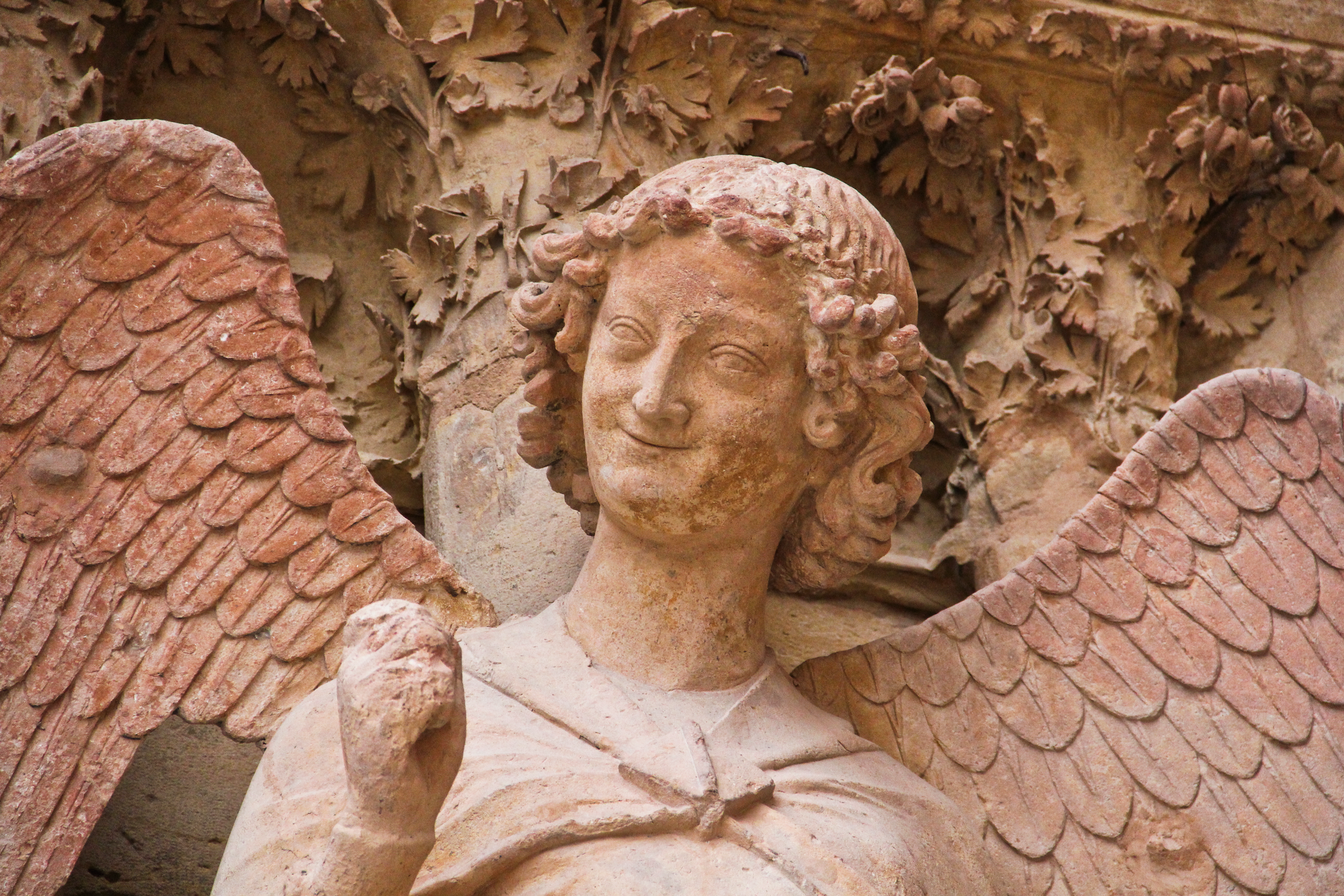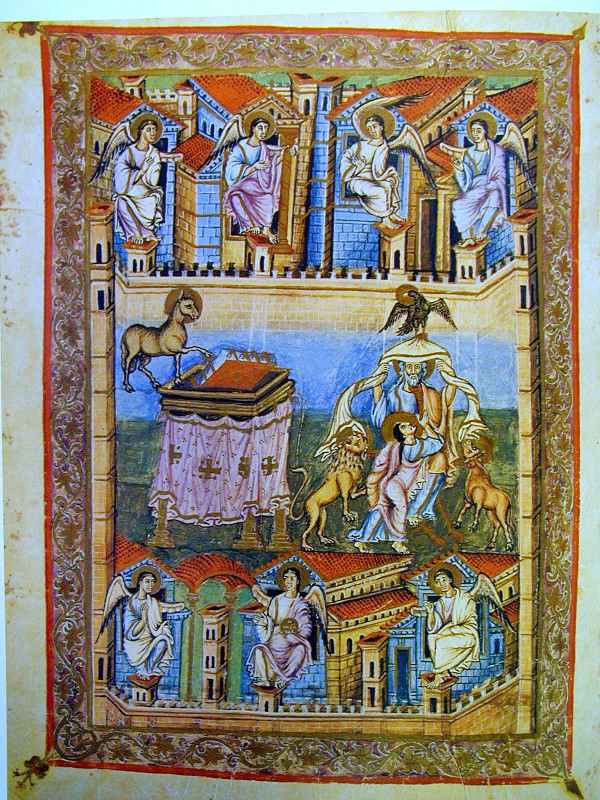|
Smiling Angel
The ''Smiling Angel'' (French: ''L'Ange au Sourire''), also known as the ''Smile of Reims'' (''Le Sourire de Reims'') or ''Angel of the Annunciation'', is a stone sculpture at the cathedral of Reims. Sculptors that were pioneers of the Gothic style came from workshops in Chartres, Paris and Amiens to work on the Reims Cathedral. The most striking aspect of the cathedral is its façade, particularly its Annunciation sculpture, which includes the "Smiling Angel”. The Angel was carved between 1236 and 1245. This figure is located on the right side of the north portal of the west facade. The statue’s flowing drapery and the illusion that the figure is detached from the façade and jamb columns behind it are typical of the International Gothic style. The Smiling Angel is comparable to a nearby statue of St. Joseph, also situated on the Reims Cathedral facade on the left jamb in the central doorway of the west portal, who shares a similar smirking facial expression. Both works a ... [...More Info...] [...Related Items...] OR: [Wikipedia] [Google] [Baidu] |
French Language
French ( or ) is a Romance language of the Indo-European family. It descended from the Vulgar Latin of the Roman Empire, as did all Romance languages. French evolved from Gallo-Romance, the Latin spoken in Gaul, and more specifically in Northern Gaul. Its closest relatives are the other langues d'oïl—languages historically spoken in northern France and in southern Belgium, which French (Francien) largely supplanted. French was also influenced by native Celtic languages of Northern Roman Gaul like Gallia Belgica and by the ( Germanic) Frankish language of the post-Roman Frankish invaders. Today, owing to France's past overseas expansion, there are numerous French-based creole languages, most notably Haitian Creole. A French-speaking person or nation may be referred to as Francophone in both English and French. French is an official language in 29 countries across multiple continents, most of which are members of the '' Organisation internationale de la Francopho ... [...More Info...] [...Related Items...] OR: [Wikipedia] [Google] [Baidu] |
Cathedral Of Reims
, image = Reims Kathedrale.jpg , imagealt = Facade, looking northeast , caption = Façade of the cathedral, looking northeast , pushpin map = France , pushpin map alt = Location within France , pushpin mapsize = , map caption = Location in France , coordinates = , country = France , location = Place du Cardinal Luçon, 51100Reims, France , membership = , attendance = , website = , bull date = , founded date = , founder = , dedication = Our Lady of Reims , dedicated date = , consecrated date = , denomination = Roman Catholic , cult = , relics = , events = , past bishop = , people = Clovis I , status = Cathedral , functional status = Active , heritage designation = , designated date = , a ... [...More Info...] [...Related Items...] OR: [Wikipedia] [Google] [Baidu] |
Annunciation
The Annunciation (from Latin '), also referred to as the Annunciation to the Blessed Virgin Mary, the Annunciation of Our Lady, or the Annunciation of the Lord, is the Christian celebration of the biblical tale of the announcement by the angel Gabriel to Mary that she would conceive and bear a son through a virgin birth and become the mother of Jesus Christ, the Christian Messiah and Son of God, marking the Incarnation. Gabriel told Mary to name her son Jesus, meaning " YHWH is salvation". According to , the Annunciation occurred "in the sixth month" of Elizabeth's pregnancy with John the Baptist. Many Christians observe this event with the Feast of the Annunciation on 25 March, an approximation of the northern vernal equinox nine full months before Christmas, the ceremonial birthday of Jesus. The Annunciation is a key topic in Christian art in general, as well as in Marian art in the Catholic Church, having been especially prominent during the Middle Ages and Re ... [...More Info...] [...Related Items...] OR: [Wikipedia] [Google] [Baidu] |
International Gothic
International Gothic is a period of Gothic art which began in Burgundy, France, and northern Italy in the late 14th and early 15th century. It then spread very widely across Western Europe, hence the name for the period, which was introduced by the French art historian Louis Courajod at the end of the 19th century. Artists and portable works, such as illuminated manuscripts, travelled widely around the continent, leading to a common aesthetic among the royalty and higher nobility and considerably reducing the variation in national styles among works produced for the courtly elites. The main influences were northern France, the Netherlands, the Duchy of Burgundy, the Imperial court in Prague, and Italy. Royal marriages such as that between Richard II of England and Anne of Bohemia helped to spread the style. It was initially a style of courtly sophistication, but somewhat more robust versions spread to art commissioned by the emerging mercantile classes and the smaller nobility ... [...More Info...] [...Related Items...] OR: [Wikipedia] [Google] [Baidu] |
Saint Joseph
Joseph (; el, Ἰωσήφ, translit=Ioséph) was a 1st-century Jewish man of Nazareth who, according to the canonical Gospels, was married to Mary, the mother of Jesus, and was the legal father of Jesus. The Gospels also name some brothers of Jesus who may have been: (1) the sons of Mary, the mother of Jesus, and Joseph; (2) sons of Mary, the wife of Clopas and sister of Mary the mother of Jesus; or (3) sons of Joseph by a former marriage. Joseph is venerated as Saint Joseph in the Catholic Church, Orthodox Church, Oriental Orthodox Church and Anglicanism. His feast day is observed by some Lutherans. In Catholic traditions, Joseph is regarded as the patron saint of workers and is associated with various feast days. The month of March is dedicated to Saint Joseph. Pope Pius IX declared him to be both the patron and the protector of the Catholic Church, in addition to his patronages of the sick and of a happy death, due to the belief that he died in the presence of Jesus ... [...More Info...] [...Related Items...] OR: [Wikipedia] [Google] [Baidu] |
Book Of Revelation
The Book of Revelation is the final book of the New Testament (and consequently the final book of the Christian Bible). Its title is derived from the first word of the Koine Greek text: , meaning "unveiling" or "revelation". The Book of Revelation is the only apocalyptic book in the New Testament canon. It occupies a central place in Christian eschatology. The author names himself as simply "John" in the text, but his precise identity remains a point of academic debate. Second-century Christian writers such as Papias of Hierapolis, Justin Martyr, Irenaeus, Melito of Sardis, Clement of Alexandria, and the author of the Muratorian fragment identify John the Apostle as the "John" of Revelation. Modern scholarship generally takes a different view, with many considering that nothing can be known about the author except that he was a Christian prophet. Modern theological scholars characterize the Book of Revelation's author as " John of Patmos". The bulk of tradition ... [...More Info...] [...Related Items...] OR: [Wikipedia] [Google] [Baidu] |
World War I
World War I (28 July 1914 11 November 1918), often abbreviated as WWI, was List of wars and anthropogenic disasters by death toll, one of the deadliest global conflicts in history. Belligerents included much of Europe, the Russian Empire, the United States, and the Ottoman Empire, with fighting occurring throughout Europe, the Middle East, Africa, the Pacific Ocean, Pacific, and parts of Asia. An estimated 9 million soldiers were killed in combat, plus another 23 million wounded, while 5 million civilians died as a result of military action, hunger, and disease. Millions more died in Genocides in history (World War I through World War II), genocides within the Ottoman Empire and in the Spanish flu, 1918 influenza pandemic, which was exacerbated by the movement of combatants during the war. Prior to 1914, the European great powers were divided between the Triple Entente (comprising French Third Republic, France, Russia, and British Empire, Britain) and the Triple A ... [...More Info...] [...Related Items...] OR: [Wikipedia] [Google] [Baidu] |
Musée National Des Monuments Français
The Musée national des Monuments Français ( en, National Museum of French Monuments) is today a museum of plaster casts of French monuments located in the Palais de Chaillot, 1, place du Trocadéro et du 11 Novembre, Paris, France. It now forms part of the Cité de l'Architecture et du Patrimoine, and is open daily except Tuesday. An admission fee is charged. The museum's name evokes the earlier Musée des Monuments français opened in 1795 by Alexandre Lenoir, which displayed actual monuments of French Medieval and Renaissance art, removed from churches and châteaux after the French Revolution. Lenoir's museum remained open until the Bourbon Restoration of 1816, and was highly influential on French taste, making the medievalism of the Troubadour style popular, and providing inspiration to its artists. History The architect Eugène Viollet-le-Duc suggested gathering reproductions of French sculpture and architecture at a single site in the palais du Trocadéro in 1879, ... [...More Info...] [...Related Items...] OR: [Wikipedia] [Google] [Baidu] |
Statues In France
A statue is a free-standing sculpture in which the realistic, full-length figures of persons or animals are carved or cast in a durable material such as wood, metal or stone. Typical statues are life-sized or close to life-size; a sculpture that represents persons or animals in full figure but that is small enough to lift and carry is a statuette or figurine, whilst one more than twice life-size is a colossal statue. Statues have been produced in many cultures from prehistory to the present; the oldest-known statue dating to about 30,000 years ago. Statues represent many different people and animals, real and mythical. Many statues are placed in public places as public art. The world's tallest statue, ''Statue of Unity'', is tall and is located near the Narmada dam in Gujarat, India. Color Ancient statues often show the bare surface of the material of which they are made. For example, many people associate Greek classical art with white marble sculpture, but there is evidenc ... [...More Info...] [...Related Items...] OR: [Wikipedia] [Google] [Baidu] |
Sculptures Of Angels
Sculpture is the branch of the visual arts that operates in three dimensions. Sculpture is the three-dimensional art work which is physically presented in the dimensions of height, width and depth. It is one of the plastic arts. Durable sculptural processes originally used carving (the removal of material) and modelling (the addition of material, as clay), in stone, metal, ceramic art, ceramics, wood and other materials but, since Modernism, there has been an almost complete freedom of materials and process. A wide variety of materials may be worked by removal such as carving, assembled by welding or modelling, or Molding (process), moulded or Casting, cast. Sculpture in stone survives far better than works of art in perishable materials, and often represents the majority of the surviving works (other than pottery) from ancient cultures, though conversely traditions of sculpture in wood may have vanished almost entirely. However, most ancient sculpture was brightly painted, ... [...More Info...] [...Related Items...] OR: [Wikipedia] [Google] [Baidu] |


.jpg)



